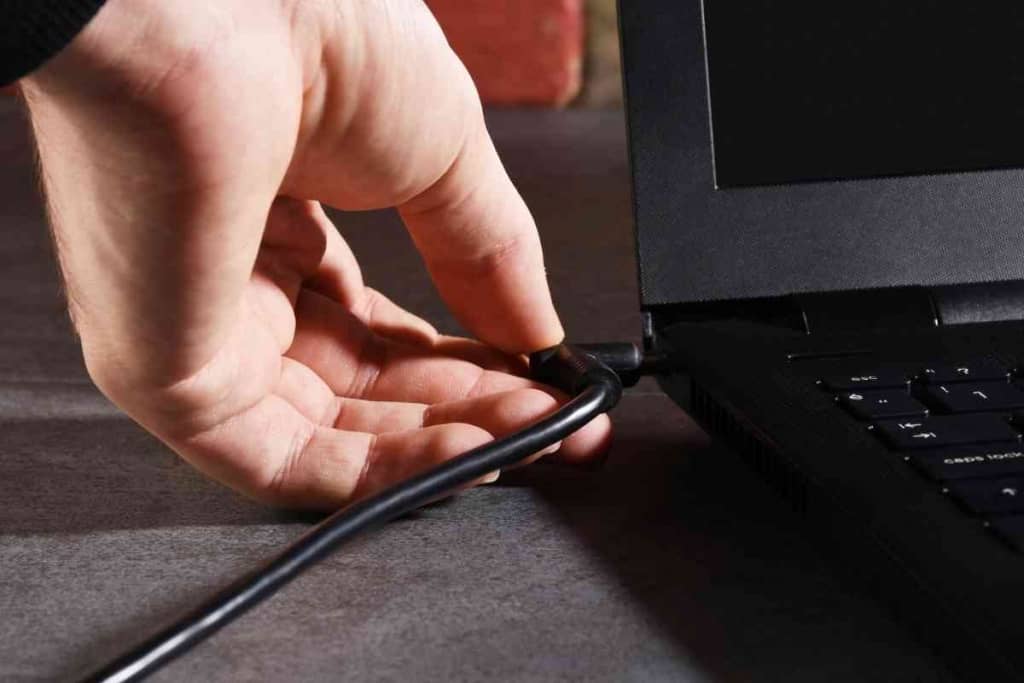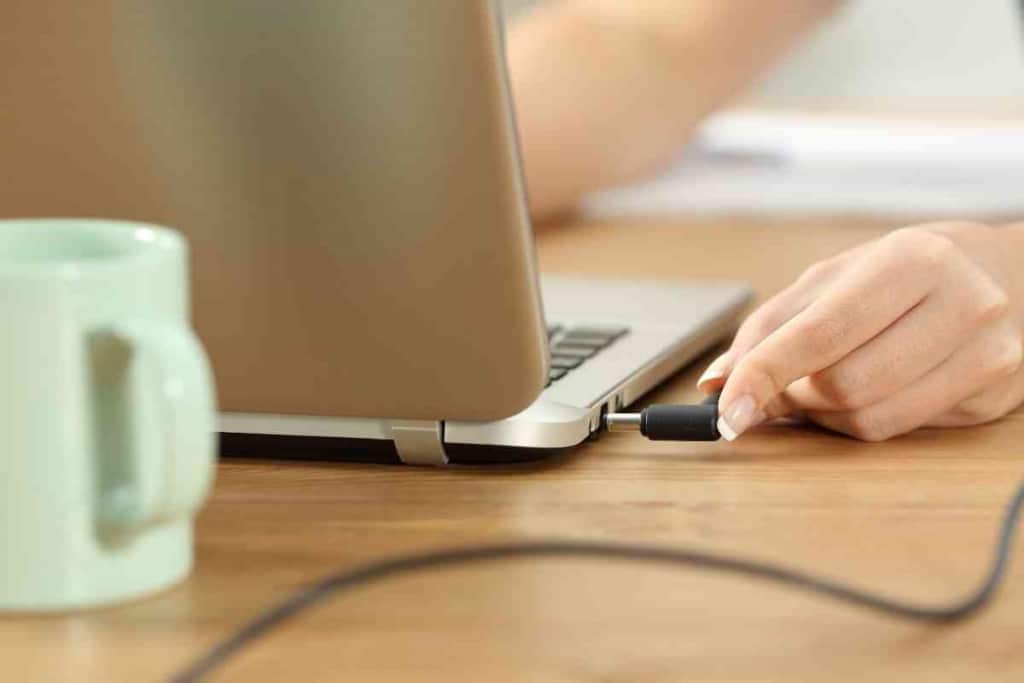Laptop Only Turns On When Plugged In: 8 Troubleshooting Steps
A laptop battery allows you to use it wherever and whenever you need it. So, if your laptop only turns on when plugged in, here’s how to troubleshoot in minutes. One of the main conveniences of a laptop that a desktop computer does not have is the fact that a laptop has a battery that can be charged to use the laptop wherever you like. Although you will only be able to operate a computer for a few hours before it needs to be charged again, having that battery can free you up to use your computer at the park, in the car (with someone else driving), and anywhere that electrical outlets may not be readily available.

Table of Contents
- Why does my laptop only turn on when it’s plugged in?
- Causes of a laptop only working when plugged in
- Other potential solutions to try
Why does my laptop only turn on when it’s plugged in?
If your laptop only works when it’s plugged in, then it could be a problem with your battery, a corrupt driver, a power settings issue, or a problem with the operating system. Most commonly the battery is the issue, but before buying a new one, you will want to troubleshoot everything.
Although issues with laptop batteries are fairly common and are most likely the cause of your laptop only working when plugged in, there are a few other things you may want to try before you shell out the cash to pay for a laptop battery replacement. The average laptop battery replacement can cost anywhere from $50 to $200 depending on the manufacturer.
Because of this, you may want to troubleshoot every potential problem since updating your operating system, reconfiguring your power settings, or reinstalling a battery driver is free.
Let us take a deep dive into all the potential causes of a laptop only working when it is plugged in and how to troubleshoot each of these potential problems. The fix may be as easy as reinstalling a driver, updating the operating system, or reconfiguring some power settings, however, you may also need to purchase a replacement battery and/or power adapter.
Causes of a laptop only working when plugged in
Before you make any purchases for a replacement battery or a new power adapter, there are several things you should look at first that could also be the problem. Here is a breakdown of some of those causes.
1. Battery is not properly connected
Sometimes the cause of a laptop only working when plugged in could be something as simple as the battery not being properly connected to the laptop. There are two types of laptop batteries. There are detachable batteries and non-removable batteries.
Detachable batteries can get bumped out of place or the connection points can become covered in dust and therefore they are unable to pass along an electrical current from the battery to the laptop.
Non-removable batteries on the other hand can also not be properly connected if the wire that runs from the battery to the motherboard becomes jarred loose. If you have a laptop with a non-removable battery, then you will need to unscrew the back cover and remove it to get access to the internal components of your laptop. Be careful to save all the screws as they are tiny and could easily get misplaced. Once the cover is removed, go ahead and find the laptop battery and identify the connection wire that runs from the battery to the motherboard.
Double-check to see that it is connected. If not, go ahead and reconnect it. If it is already connected, try disconnecting the wire and reconnecting it.
If you have a laptop with a detachable battery, go ahead and remove the battery from the back of the laptop. Once you have the battery in your hand, go ahead and use a microfiber cloth to clean off all of the metallic connection points on the battery as well as the connection points in the battery docking station. Once everything has been properly cleaned, reattach the battery carefully and accurately to ensure that everything is properly aligned.
2. A corrupted driver
Drivers and device drivers are essential to allow communication between pieces of hardware and the computer’s operating system. Every piece of hardware has a driver including the battery. If your laptop is only running when the power adapter is plugged in, it could be a sign that the battery driver on your laptop has become corrupted, was not properly installed, or was accidentally uninstalled.
To address the issue of a corrupted driver, you then should uninstall and reinstall all of the battery drivers in your laptop’s “Device Manager”.
3. Improper power settings
Every laptop has power settings, and more specifically, power settings that can directly impact battery life, charging time, and the battery’s functionality. If you have recently changed your power settings in any way, you may want to consider changing them back to how you had them previously when the laptop was able to function normally with only the battery.
Also, suppose it is the case you have not changed your power settings but suddenly you cannot run your laptop without the power adapter. In that case, you may want to try changing the power settings of your laptop to see if any of the settings recognize your laptop battery as a power source when it is not plugged in.

4. Windows update
Have you ever noticed that your laptop may run poorly after a Windows update? You are not alone and it can be incredibly frustrating since the updates are often mandatory and are completed when you simply reset your computer or power it on.
Yes, there are many good reasons to always make sure your laptop is updating with the latest operating system patches, however, sometimes the updates can come with bugs or they can corrupt drivers. If your laptop suddenly will only run when it is plugged in and you have recently updated Windows, you may have had your battery drivers corrupted or uninstalled. You will need to uninstall and reinstall all of your battery drivers.
5. Battery is low
Sometimes your laptop battery could be completely drained without your knowledge. This can happen if your laptop is not plugged in and you leave it on or in sleep mode for too long. It may sound stupid, but it is more common than you think.
Before you do anything, you may want to simply just close your laptop, plug it in, and let it charge for a few hours. Once it has had sufficient time to charge, then check to see if the laptop will work without being plugged in. If you left the computer charging for a few hours and the battery meter says 0%, then you may need to purchase a replacement battery since your current battery is not holding a charge.
6. Issues with the AC power adapter
Sometimes an AC power adapter may be starting to fail, and even though it can still provide enough power to keep your laptop running, it may not have enough power to keep the laptop running and charge the battery at the same time.
Two things you can try to see if this may be the issue.
First, go ahead and shut down the laptop and then leave it plugged in for a few hours. If the laptop is not up and running, the AC adapter may be able to have enough power to charge the battery.
Second, if you have a friend or family member with the same brand of laptop, you may want to have them come over with their AC power adapter or bring your laptop to their place to test out their power chord.
If it works perfectly with their AC adapter, then you may need to purchase a new charging cable.
7. Battery heath is degrading
As laptop batteries get older, their overall health can degrade to a point where they may not hold a charge. This can be especially true if you keep your laptop plugged in.
Keeping your laptop plugged in all the time can increase the rate of battery health degradation.
If your laptop battery is on the verge of failing, you may notice that the battery life depletes rapidly, it can take much longer for the battery to charge fully, and/or the battery does not hold a charge at all and the only way the laptop will run is when it is plugged in. Also, if the battery is failing, the likelihood that the laptop will overheat can increase significantly.
8. Using the wrong port
Depending on the age of your laptop, you may have the newer USB-C charging port on your laptop versus the old style of plug.
If this is the case, you may have two different USB-C ports on your laptop. One of the ports is typically designated for data transfers while the other is connected to the battery.
If you have a newer laptop with USB-C ports, then you may need to double-check that you are charging your laptop’s battery by plugging in the charging cable to the correct port.
Other potential solutions to try
One last thing you may want to try before purchasing a new battery for your laptop is the power-down method. There are two ways to implement the power-down method to completely drain all the power from your laptop to ideally remove any settings.
1st power-down method
First, you will want to turn off your laptop and disconnect the charger. Next, detach the battery from the back of the laptop, or if you have a laptop with an unremovable battery, you may need to open up the bottom of the laptop and disconnect the wire connecting the battery to the motherboard.
Once the battery has been removed or disabled, hold down the laptop’s power button for two minutes. After approximately two minutes, go ahead and reattach the battery or reconnect the wire from the battery to the motherboard. Without plugging the AC adapter into the wall, go ahead and try to power on your laptop to see if it will now run.
2nd power-down method
First, turn off the power on your laptop and disconnect the battery and the power cord. Also, make sure you remove any other devices that are connected to any of the USB ports located on the laptop.
Next, go ahead and remove the back or the bottom of your laptop and locate your laptop’s motherboard. You are going to want to eject the CMOS battery from the motherboard. It should look like a small coin. After the CMOS battery is ejected, go ahead and press the power button and hold it down for two minutes.
After two minutes, go ahead and reconnect the battery and power on the laptop to see if it will run normally.